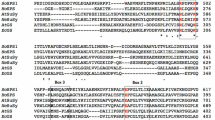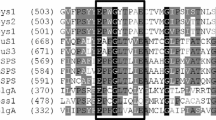Abstract
Sucrose phosphate synthase (SPS) is believed to be the key enzyme for controlling the biosynthesis of sucrose. SPSs consist of a functional glycosyltransferase domain that shares conserved residues with the glycosyltransferase domain of sucrose biosynthesis-related protein. The formation of sucrose-6-phosphate is catalyzed by SPS with the transfer of a glycosyl group of uridine diphosphate glucose (UDP-G) as an activated donor sugar to a fructose-6-phosphate as a sugar acceptor. However, understanding of the mechanism of catalytic and substrate binding in SPS is very limited. Based on amino acid sequence alignments with several enzymes that belong to the glycosyltransferase family, the UDP-G binding sites that might be critical for catalytic mechanism were identified. Here, we report that single point mutation of R496, D498, and V570 located in the proposed UDP-G binding site led to less active or complete loss of enzyme activity. Through structure-based site-directed mutagenesis and biochemical studies, the results indicated that these residues contribute to the catalytic activity of plant SPS. Moreover, understanding of the UDP-G binding site provides an insight into new strategies for enzyme engineering and redesigning a catalytic mechanism for UDP.


Similar content being viewed by others
Abbreviations
- F6P:
-
Fructose-6-phophate
- G6P:
-
Glucose-6-phosphate
- SPS:
-
Sucrose phosphate synthase
- UDP-G:
-
Uridine diphosphate glucose;
References
Amir J, Preiss J (1982) Kinetic characterization of spinach leaf sucrose-phosphate synthase. Plant Physiol 69:1027–1030
Baroja-Fernández E, Muñoz FJ, Saikusa T, Rodríguez-López M, Akazawa T, Pozueta-Romero J (2003) Sucrose synthase catalyzes the de novo production of ADPglucose linked to starch biosynthesis in heterotrophic tissues of plants. Plant Cell Physiol 44(5):500–509
Baskaran S, Roach PJ, Depaoli-Roach AA, Hurley TD (2010) Structural basis for glucose-6-phosphate activation of glycogen synthase. Proc Natl Acad Sci U S A 107(41):17563–17568
Breton C, Imberty A (1999) Structure/function studies of glycosyltransferases. Curr Opin Struct Biol 9:563–571
Castleden CK, Aoki N, Gillespie VJ, MacRae EA, Quick WP, Buchner P, Foyer CH, Furbank RT, Lunn JE (2004) Evolution and function of the sucrose phosphate synthase gene families in wheat and other grasses. Plant Physiol 135:1753–1764
Chua TK, Bujnicki JM, Tan TC, Hyunh F, Patel BK, Sivaraman J (2008) The structure of sucrose phosphate synthase from Halothermothrix orenii reveals its mechanism of action and binding mode. Plant Cell 20:1059–1072
Coutinho PM, Deleury E, Davies GJ, Henrissat B (2003) An evolving hierarchical family classification for glycosyltransferases. J Mol Biol 328:307–317
Cumino A, Curatti L, Giarrocco L, Salerno GL (2002) Sucrose metabolism: anabaena sucrose-phosphate synthase and sucrose-phosphate phosphatase define minimal functional domains shuffled during evolution. FEBS Lett 517:19–23
Diricks M, Bruyn FD, Daele PV, Walmagh M, Desmet T (2015) Identification of sucrose synthase in nonphotosynthetic bacteria and characterization of the recombinant enzymes. Appl Microbiol Biotechnol 99:8465–8474
Gifford RM, Thorne JH, Hitz WD, Giaquinta RT (1984) Crop productivity and photoassimilate partitioning. Science 225:801–808
Huber SC, Huber JL (1996) Role and regulation of sucrose-phosphate synthase in higher plants. Annu Rev Plant Physiol Plant Mol Biol 47:431–444
Huber SC, Kerr PS, Rufty TW (1985) Diurnal changes in sucrose phosphate synthase activity in leaves. Plant Physiol 64:81–87
Imberty A, Wimmerova M, Koca J, Breton C (2006) Molecular modeling of glycosyltransferases. In: Brockhausen I (ed) Methods in molecular biology, 347: Glycobiology protocols. Humana, Totowa, pp 145–156
Laemmli UK (1970) Cleavage of structural proteins during the assembly of the head of bacteriophage T4. Nature 227:680–685
Lairson LL, Henrissat B, Davies GJ, Withers SG (2008) Glycosyltransferases: structures, functions, and mechanisms. Annu Rev Biochem 77:521–555
Leloir LF, Cardini CE (1955) The biosynthesis of sucrose phosphate. J Biol Chem 214:157–165
Lunn JE, MacRae E (2003) New complexities in the synthesis of sucrose. Curr Opin Plant Biol 6:208–214
Lunn JE, Price GD, Furbank RT (1999) Cloning and expression of a prokaryotic sucrose-phosphate synthase gene from the cyanobacterium Synechocystis sp. PCC 6803. Plant Mol Biol 40:297–305
Pontis HG (1978) On the scent of the riddle of sucrose. Trends Biochem Sci 3:137–139
Salerno GL, Curatti L (2003) Origin of sucrose metabolism in higher plants: when, how and why? Trends Plant Sci 8:63–69
Sawitri WD, Narita H, Ishizaka-Ikeda E, Sugiharto B, Hase T, Nakagawa A (2016) Purification and characterization of recombinant sugarcane sucrose phosphate synthase expressed in E. coli and insect Sf9 cells: an importance of the N-terminal domain for an allosteric regulatory property. J Biochem 159(6):599–607
Sheng F, Jia X, Yep A, Preiss J, Geiger JH (2009) The crystal structures of the open and catalytically competent closed conformation of Escherichia coli glycogen synthase. J Biol Chem 284(26):17796–17807
Sugiharto B, Sakakibara H, Sumadi, Sugiyama T (1997) Differential expression of two genes for sucrose-phosphate synthase in sugarcane: molecular cloning of the cDNAs and comparative analysis of gene expression. Plant Cell Physiol 38(8):961–965
Tarbouriech N, Chamock SJ, Davies GJ (2001) Three-dimensional structures of the Mn and mg dTDP complexes of the family GT-2 glycosyltransferase spsA: a comparison with related NDP-sugar glycosyltransferases. J Mol Biol 314:655–661
Ünligil UM, Rini JM (2000) Glycosyltransferase structure and mechanism. Curr Opin Struct Biol 10:510–517
Wu R, Diez MDA, Figueroa CM, Matchey M, Iglesias AA, Ballicora MA, Liu D (2015) The crystal structure of Nitrosomonas europaea sucrose synthase reveals critical conformational changes and insights into sucrose metabolism in prokaryotes. J Bacteriol 197(17):2734–2746
Zheng Y, Anderson S, Zhang Y, Garavito RM (2011) The structure of sucrose synthase-1 from Arabidopsis thaliana and its functional implications. J Biol Chem 286(41):36108–36118
Acknowledgements
This work was supported by Ministry of Research, Technology and Higher Education of the Republic of Indonesia (Penelitian Unggulan Strategis Nasional and Penelitian Dasar Unggulan Perguruan Tinggi) and by the International Collaborative Research Program of Institute for Protein Research, Osaka University, ICR-14-03 and 05, Japan.
Author information
Authors and Affiliations
Corresponding author
Ethics declarations
Conflict of interest
Widhi Dyah Sawitri declares that she has no conflicts of interest. Siti Nurul Afidah declares that she has no conflicts of interest. Atsushi Nakagawa declares that he has no conflicts of interest. Toshiharu Hase declares that he has no conflicts of interest. Bambang Sugiharto declares that he has no conflicts of interest.
Ethical approval
This article does not contain any studies with human participants or animals performed by any of the authors.
Additional information
This article is part of a Special Issue on ‘Biomolecules to Bio-nanomachines - Fumio Arisaka 70th Birthday’ edited by Damien Hall, Junichi Takagi and Haruki Nakamura.
Rights and permissions
About this article
Cite this article
Sawitri, W.D., Afidah, S.N., Nakagawa, A. et al. Identification of UDP-glucose binding site in glycosyltransferase domain of sucrose phosphate synthase from sugarcane (Saccharum officinarum) by structure-based site-directed mutagenesis. Biophys Rev 10, 293–298 (2018). https://doi.org/10.1007/s12551-017-0360-9
Received:
Accepted:
Published:
Issue Date:
DOI: https://doi.org/10.1007/s12551-017-0360-9




